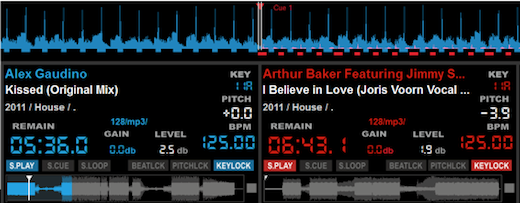
Ever bought a hot new compilation of new tunes right before a gig, but been afraid to use it? While in general it’s considered risky business to mix music you are not fully familiar with, sometimes – for instance, in a warm-up, or to make an upfront mixtape – you may want to play not just one but a whole bunch of tunes you don’t know so well.
It’s almost invariably not the best idea. But if you do decide to play a set with music you’re not full familiar with, as a digital DJ you have many more tools available than you might realise to deliver a great sounding mix without knowing the ins and outs of the tracks. This article will give you some guidelines to get way more comfortable mixing unknown content.
(Incidentally, most of this information is equally relevant to DJing even if you know your material intimately – it’s just that while it’s often perfectly possible to “wing it” with material you’re truly familiar with, disregarding all of this, obviously when you don’t know the tracks as well, you really do need to use all the tools at your disposal…)
Especially with material you don’t know well, using key mixing is a godsend, so before we start, make sure you understand the rules of keymixing (read our 1-2-3 of Mixing in Key article for a refresher) and stick to them.
1. Prepare with your head
Smart DJs realise it all starts out with information. When you’re adding new music to your collection, make sure you spend that extra ten minutes to be critical and thorough on the metadata (tags) of your files before adding them to your DJ software database:
- Fix the track info – If the artist, title and remix are missing or incomplete, find the track on Discogs and use iTunes (if you use it), beaTunes or a tool like Jaikoz Audio Tagger to update the ID3 tags
- Sort your genres – Be critical here. Too many subgenres will mess up your ability to quickly search for a suitable track. Handpick the main genre you feel is appropriate for each new track
- Add BPM and key – Knowing the BPM and the key of a track are bare requirements for spontaneous mixing. Even though some DJ software is able to do its own BPM and key detection, it’s best to use a dedicated tool like Mixed In Key to update the metadata with the tempo and key, because even if you play a track your DJ software has never seen before, this ensures that the info is immediately available to you in your library when browsing
Immediately before you begin…
So here you are, you have all your tracks imported with accurate and complete metadata. At this stage, especially if you’re planning on mixing a whole bunch of material you don’t know so well, a bit of planning goes a long way. Take a few minutes to think of what you want to achieve, the general build up and flow, optional change of (sub)genre and tempo, the interaction with the audience if applicable, and so on. With this in mind, pre-listen the intros of your fresh tracks.
If you use sync and beatgridding, now’s the time to look for any misalignment of first beats that could cause issues.
2. Plan with your eyes
With harmonic mixing especially, it is perfectly possible to perform long mixes without it sounding unnatural – as long as you know your tunes of course, so you can choose the best sections to mix.
But since you don’t know the music so well, the big questions are: What would be the best moment to start my mix? When are the drops? When are the buildups? How long is the intro of the other track? This is where a quick study of the waveforms of the tracks – or, as we like to refer to it, waveriding – will help you out immeasurably. For instance, take a look at the waveforms (bottom of the screengrab) of these two tunes:

Here’s what we can deduce from the waveforms:
- Track 1 probably has a steady basic beat, bass only intro, drops, has a small build up and goes into full power followed by one more drop, longer build up, full power and build off
- Track 2 looks like a very gentle intro, steady opening with little drop, than long build up, full power, even longer build up and no true ending
When envisioning your mix, imagine the two waveforms on top of each other and keep any big difference in duration in mind (some software puts little lines at one-minute and five-minute intervals so you can see how long the segments you are looking at actually are in “real” time). For example, consider these:

The second buildup of the left track would be in sync with the first buildup of the right, both tracks “kicking in” again at the same time. It makes sense to to exit the left track immediately after the first buildup of the right track or right before the second buildup of the right track. Of course in most software you won’t be able to see those two aligned like this when you’re previewing, and some software doesn’t even have parallel waveforms when you’re actually playing, so in those cases you have to estimate – but you quickly get a knack of working out how long segments are.
3. Mix with your ears
Ultimately it’s your ears that will take the decision when to start a mix. In most cases electronic music is very predictable. It is usually built up from patterns that contain eight bars of four beats, with these patterns repeating with variations. This predictability is nice for a dancing crowd and equally for the DJ.
Your biggest chance for getting the tracks aligned exactly as you’ve imagined it is to start the track at the point you estimate you should be starting with, not just with their beats but also their patterns in sync – just as you would anyway. But when you’re not familiar with the tracks, the usual counting in eight sets of four bars (“1, 2, 3, 4” on the beat eight times) is especially important.
If you realise you were a few bars too early or late you can just loop a bar on one of the decks to delay the track until your patterns line up the correct one. As long as there are no vocals and not much other musical information going on, this can often be practically unnoticeable. Once you got your second track started and in time, you can focus entirely on the mix. You’ve studied the tracks’ flow; you know when your exit is going to be. Now you can just be creative with mixing them together as you feel is most appropriate, using volume, EQ, filters – whatever your ears tells you sounds good.
Finally…
Finally, when mixing unfamiliar material, remember that simpler is nearly always better – best to get the tracks together tightly, professionally and with the minimum of fuss.
Also, always be aware that just around the corner there may be an element in one or other of the tracks that you’re not expecting that could make the mix start to sound wrong – so be ready to complete your mix if things start to go off at a less than ideal tangent!
• Jan Boerlage is a DJ and writer. Listen to his sets over on his Mixcloud page.
Have you ever been forced to play from someone else’s music, or for some other reason ended up DJing with a whole pile of track you don’t know? Do you enjoy doing this when practising, for instance, or to learn your new music? And tips and tricks you’d like to add?







![How To DJ Warm Up Sets [Live DJing Q&A With Phil Morse] How To DJ Warm Up Sets [Live DJing Q&A With Phil Morse]](https://cdn.digitaldjtips.com/app/uploads/2023/06/10150042/546463301-warmpup-blank-website.jpg)
